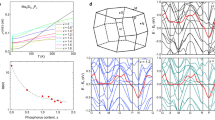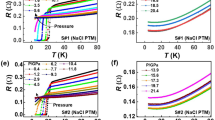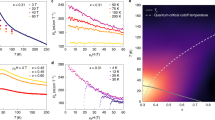Abstract
In contrast to conventional Fermi liquids where resistivity scales quadratically with temperature, unconventional superconductors usually exhibit a normal-state resistivity that varies as a linear function of temperature (T-linear) in the low-temperature limit. This phenomenon, termed as the strange metal, has been extensively studied in cuprates and is thought to be intimately linked to superconductivity. A quantitative description of its relationship with superconductivity is, therefore, of great importance for developing further theoretical understanding; however, so far, comprehensive studies are scarce due to the difficulties in realizing a systematic control of the superconducting state. Here we report the observation of a typical strange-metal behaviour in FeSe, namely, T-linear resistivity, linear-in-field magnetoresistance and universal scaling of magnetoresistance. More importantly, when we tune the superconductivity by ionic-liquid gating, the superconducting transition temperature increases from approximately 10 to 45 K, and the T-linear resistivity coefficient exhibits a quadratic dependence on the critical temperature. This is a ubiquitous feature that describes the relation between these parameters in various systems including overdoped cuprates and Bechgaard salts. This suggests that there may be a universal mechanism underlying the T-linear resistivity and unconventional superconductivity.
This is a preview of subscription content, access via your institution
Access options
Access Nature and 54 other Nature Portfolio journals
Get Nature+, our best-value online-access subscription
$29.99 / 30 days
cancel any time
Subscribe to this journal
Receive 12 print issues and online access
$209.00 per year
only $17.42 per issue
Buy this article
- Purchase on Springer Link
- Instant access to full article PDF
Prices may be subject to local taxes which are calculated during checkout



Similar content being viewed by others
Data availability
Source data are provided with this paper. All other data that support the findings of this study are available from the corresponding authors upon reasonable request.
References
Cooper, R. A. et al. Anomalous criticality in the electrical resistivity of La2–xSrxCuO4. Science 323, 603–607 (2009).
Jin, K., Butch, N. P., Kirshenbaum, K., Paglione, J. & Greene, R. L. Link between spin fluctuations and electron pairing in copper oxide superconductors. Nature 476, 73–75 (2011).
Bruin, J. A. N., Sakai, H., Perry, R. S. & Mackenzie, A. P. Similarity of scattering rates in metals showing T-linear resistivity. Science 339, 804–807 (2013).
Legros, A. et al. Universal T-linear resistivity and Planckian dissipation in overdoped cuprates. Nat. Phys. 15, 142–147 (2019).
Licciardello, S. et al. Electrical resistivity across a nematic quantum critical point. Nature 567, 213–217 (2019).
Hayes, I. M. et al. Scaling between magnetic field and temperature in the high-temperature superconductor BaFe(As1–xPx)2. Nat. Phys. 12, 916–919 (2016).
Giraldo-Gallo, P. et al. Scale-invariant magnetoresistance in a cuprate superconductor. Science 361, 479–481 (2018).
Sarkar, T., Mandal, P. R., Poniatowski, N. R., Chan, M. K. & Greene, R. L. Correlation between scale-invariant normal-state resistivity and superconductivity in an electron-doped cuprate. Sci. Adv. 5, eaav6753 (2019).
Licciardello, S. et al. Coexistence of orbital and quantum critical magnetoresistance in Fe1–xSx. Phys. Rev. Research 1, 023011 (2019).
Grissonnanche, G. et al. Linear-in temperature resistivity from an isotropic Planckian scattering rate. Nature 595, 667–672 (2021).
Ayres, J. et al. Incoherent transport across the strange-metal regime of overdoped cuprates. Nature 595, 661–666 (2021).
Putzke, C. et al. Reduced Hall carrier density in the overdoped strange metal regime of cuprate superconductors. Nat. Phys. 17, 826–831 (2021).
Daou, R. et al. Linear temperature dependence of resistivity and change in the Fermi surface at the pseudogap critical point of a high-Tc superconductor. Nat. Phys. 5, 31–34 (2009).
Analytis, J. G. et al. Transport near a quantum critical point in BaFe2(As1–xPx)2. Nat. Phys. 10, 194–197 (2014).
Taillefer, L. Scattering and pairing in cuprate superconductors. Annu. Rev. Condens. Matter Phys. 1, 51–70 (2010).
Yuan, J. et al. Scaling of the strange-metal scattering in unconventional superconductors. Nature 602, 431–436 (2022).
Kasahara, S. et al. Evolution from non-Fermi- to Fermi-liquid transport via isovalent doping in BaFe2(As1–xPx)2 superconductors. Phys. Rev. B 81, 184519 (2010).
Miyata, Y., Nakayama, K., Sugawara, K., Sato, T. & Takahashi, T. High-temperature superconductivity in potassium-coated multilayer FeSe thin films. Nat. Mater. 14, 775–779 (2015).
Guo, J. et al. Superconductivity in the iron selenide KxFe2Se2. Phys. Rev. B 82, 180520 (2010).
Burrard-Lucas, M. et al. Enhancement of the superconducting transition temperature of FeSe by intercalation of a molecular spacer layer. Nat. Mater. 12, 15–19 (2013).
Lei, B. et al. Evolution of high-temperature superconductivity from a low-Tc phase tuned by carrier concentration in FeSe thin flakes. Phys. Rev. Lett. 116, 077002 (2016).
Shiogai, J., Ito, Y., Mitsuhashi, T., Nojima, T. & Tsukazaki, A. Electric-field-induced superconductivity in electrochemically etched ultrathin FeSe films on SrTiO3 and MgO. Nat. Phys. 12, 42–46 (2016).
Feng, Z. et al. Tunable critical temperature for superconductivity in FeSe thin films by pulsed laser deposition. Sci. Rep. 8, 4039 (2018).
Ye, J. T. et al. Superconducting dome in a gate-tuned band insulator. Science 338, 1193–1196 (2012).
Chen, Q. H. et al. Inducing and manipulating heteroelectronic states in a single MoS2 thin flake. Phys. Rev. Lett. 119, 147002 (2017).
Jeong, J. et al. Suppression of metal-insulator transition in VO2 by electric field–induced oxygen vacancy formation. Science 339, 1402–1405 (2013).
Lu, N. et al. Electric-field control of tri-state phase transformation with a selective dual-ion switch. Nature 546, 124–128 (2017).
Leng, X. et al. Insulator to metal transition in WO3 induced by electrolyte gating. npj Quantum Mater. 2, 35 (2017).
Qin, M. et al. In situ magnetic measurements of ionic-liquid-gated superconducting films. J. Supercond. Nov. Magn. 33, 159–163 (2020).
Kinney, J., Garcia-Barriocanal, J. & Goldman, A. M. Homes scaling in ionic liquid gated La2CuO4+x thin films. Phys. Rev. B 92, 100505 (2015).
He, X., Gozar, A., Sundling, R. & Božović, I. High-precision measurement of magnetic penetration depth in superconducting films. Rev. Sci. Instrum. 87, 113903 (2016).
Duan, M.-C. et al. Development of in situ two-coil mutual inductance technique in a multifunctional scanning tunneling microscope. Rev. Sci. Instrum. 88, 073902 (2017).
Wang, Z. et al. The upper critical field and its anisotropy in (Li1–xFex)OHFe1–ySe. J. Phys. Condens. Matter 29, 025701 (2016).
Božović, I., He, X., Wu, J. & Bollinger, A. T. Dependence of the critical temperature in overdoped copper oxides on superfluid density. Nature 536, 309–311 (2016).
Sun, J. P. et al. Dome-shaped magnetic order competing with high-temperature superconductivity at high pressures in FeSe. Nat. Commun. 7, 12146 (2016).
Moriya, T. & Ueda, K. Spin fluctuations and high temperature superconductivity. Adv. Phys. 49, 555–606 (2000).
Rosch, A. Magnetotransport in nearly antiferromagnetic metals. Phys. Rev. B 62, 4945–4962 (2000).
Doiron-Leyraud, N. et al. Correlation between linear resistivity and Tc in the Bechgaard salts and the pnictide superconductor Ba(Fe1–xCox)2As2. Phys. Rev. B 80, 214531 (2009).
Wang, Q. et al. Magnetic ground state of FeSe. Nat. Commun. 7, 12182 (2016).
Chen, T. et al. Anisotropic spin fluctuations in detwinned FeSe. Nat. Mater. 18, 709–716 (2019).
Hanzawa, K., Sato, H., Hiramatsu, H., Kamiya, T. & Hosono, H. Electric field-induced superconducting transition of insulating FeSe thin film at 35 K. Proc. Natl Acad. Sci. USA 113, 3986–3990 (2016).
Ying, T. P. et al. Discrete superconducting phases in FeSe-derived superconductors. Phys. Rev. Lett. 121, 207003 (2018).
Shikama, N. et al. Enhancement of superconducting transition temperature in electrochemically etched FeSe/LaAlO3 films. Appl. Phys. Express 13, 083006 (2020).
Berben, M. et al. Compartmentalizing the cuprate strange metal. Preprint at https://arxiv.org/abs/2203.04867 (2022).
Fernandes, R. M. et al. Iron pnictides and chalcogenides: a new paradigm for superconductivity. Nature 601, 35–44 (2022).
Sprau, P. O. et al. Discovery of orbital-selective Cooper pairing in FeSe. Science 357, 75–80 (2017).
Si, Q., Yu, R. & Abrahams, E. High-temperature superconductivity in iron pnictides and chalcogenides. Nat. Rev. Mater. 1, 16017 (2016).
Villar Arribi, P. & de’ Medici, L. Hund-enhanced electronic compressibility in FeSe and its correlation with Tc. Phys. Rev. Lett. 121, 197001 (2018).
Acknowledgements
We thank R. Yu, H. Xie, D. Zhang, G. Xu, Z. Zhang, G. Zhang, K. Liu, X. Wu, G. He, L. Liang and B. Leridon for stimulating discussions. This work was supported by the National Key Basic Research Program of China (2022YFA1403900 (J.H., Q.C., K. Jiang), 2022YFA1403000 (Q.C.), 2021YFA0718700 (K. Jin), 2017YFA0302900 (T.X., K. Jin)), the National Natural Science Foundation of China (12225412 (K. Jin), 11834016 (K. Jin, J.Y.), 11888101 (T.X.), U1832214 (M.Y., J.W.), 11874359 (Z.W.), 11927808 (K. Jin, J.Y.), 11961141008 (B.Z.) and 12274439 (Y.L.)), the Beijing Nova Program of Science and Technology (Grant No. 20220484014 (Q.C.)), the Strategic Priority Research Program (B) of the Chinese Academy of Sciences (XDB25000000 (K. Jin), XDB33000000 (Q.C.)), Beijing Natural Science Foundation (Z190008 (K. Jin, J.Y., Q.C.)), CAS Project for Young Scientists in Basic Research (2022YSBR-048 (K. Jin, J.Y., Y.L.)). The Key Area Research and Development Program of Guangdong Province (grant no. 2020B0101340002 (K. Jin)). A portion of this work was performed on the Steady High Magnetic Field Facilities, High Magnetic Field Laboratory, Chinese Academy of Sciences, and supported by the High Magnetic Field Laboratory of Anhui Province. The pulsed field measurements were performed at Wuhan National High Magnetic Field Center, Huazhong University of Science and Technology.
Author information
Authors and Affiliations
Contributions
Q.C., K. Jin. and Zhongxian Zhao conceived and supervised the project. Q.C., X.J., M.Q. and X.W. performed the electrical transport and TCMI measurements. M.Q. and R.Z. designed the TCMI measurement device. M.Q., L.X. and Q.C. performed the high-magnetic-field measurements, with help from J.K., H.Z., R.Z., Q.L., Z. Wei, P.X., C.X., Z. Wang, M.Y. and J.W. Zhanyi Zhao, Z.L., Z.F. and F.C. synthesized the FeSe films. X.J. and Q.C. analysed the experimental data, with assistance from J.Y., B.Z. and Y.L. T.X., J.H. and K. Jiang contributed to the theoretical discussions. X.J., Q.C. and K. Jin wrote the manuscript with input from all authors.
Corresponding authors
Ethics declarations
Competing interests
The authors declare no competing interests.
Peer review
Peer review information
Nature Physics thanks Ivan Bozovic, Luca de’ Medici and the other, anonymous, reviewer(s) for their contribution to the peer review of this work.
Additional information
Publisher’s note Springer Nature remains neutral with regard to jurisdictional claims in published maps and institutional affiliations.
Extended data
Extended Data Fig. 1 The imaginary part of the pick-up signal.
ImVp as a function of temperature in successive gating sequences, with one-to-one correspondence (same colour coding) to the data in Fig. 2b of the main text.
Extended Data Fig. 2 Linear- to quadratic-in-H crossover of MR.
Normalized resistivity [\(\tilde \rho = \rho (T,H)/\rho \left( {250{{{\mathrm{K}}}},0{{{\mathrm{T}}}}} \right)\)] as a function of field at different temperatures for a gated FeSe film with a, Tc ≈ 35 K and b, Tc ≈ 43 K. From the bottom to the top curve in each panel, the temperatures are a, 30, 33, 36, 39, 42, 46 and 50 K, and b, 36, 39, 42, 45, 48, 51, 55, 60, 65 and 70 K. The black dashed and blue dashed lines are fits using linear- and H2-dependence, respectively.
Extended Data Fig. 3 Normal-state transport of an ion-gated FeSe film.
Temperature dependence of resistivity for an ion-gated state with Tc ≈ 43 K, at 0T (solid line) and 50 T (red dots). The dashed line is a linear guide.
Extended Data Fig. 4 Tc versus \(A_{1^\square }\) plots for different unconventional superconductors.
Symbols are data extracted from literature and solid curves are fits with the formula (\(\tilde A_{1^\square }\))n = αTc+β, where n is a fitting parameter. Data for La2–xSrxCuO4, are extracted from ref. 34; data for (TMTSF)2PF6 and Tl2Ba2CuO6+δ (Tl2201) are from ref. 16 and references therein; data for (Pb/La)-doped Bi2Sr2CuO6+δ (Bi2201) are extracted from ref. 44. The error bars are reproduced from published data and reflect the uncertainty in determining Tc and the T-linear coefficient.
Supplementary information
Supplementary Information
Supplementary Sections 1–7.
Source data
Source Data Fig. 1
Source data for Fig. 1.
Source Data Fig. 2
Source data for Fig. 2.
Source Data Fig. 3
Source data for Fig. 3.
Source Data Extended Data Fig. 1
Source data for Extended Data Fig. 1.
Source Data Extended Data Fig. 2
Source data for Extended Data Fig. 2.
Source Data Extended Data Fig. 3
Source data for Extended Data Fig. 3.
Source Data Extended Data Fig. 4
Source data for Extended Data Fig. 4.
Rights and permissions
Springer Nature or its licensor (e.g. a society or other partner) holds exclusive rights to this article under a publishing agreement with the author(s) or other rightsholder(s); author self-archiving of the accepted manuscript version of this article is solely governed by the terms of such publishing agreement and applicable law.
About this article
Cite this article
Jiang, X., Qin, M., Wei, X. et al. Interplay between superconductivity and the strange-metal state in FeSe. Nat. Phys. 19, 365–371 (2023). https://doi.org/10.1038/s41567-022-01894-4
Received:
Accepted:
Published:
Issue Date:
DOI: https://doi.org/10.1038/s41567-022-01894-4



